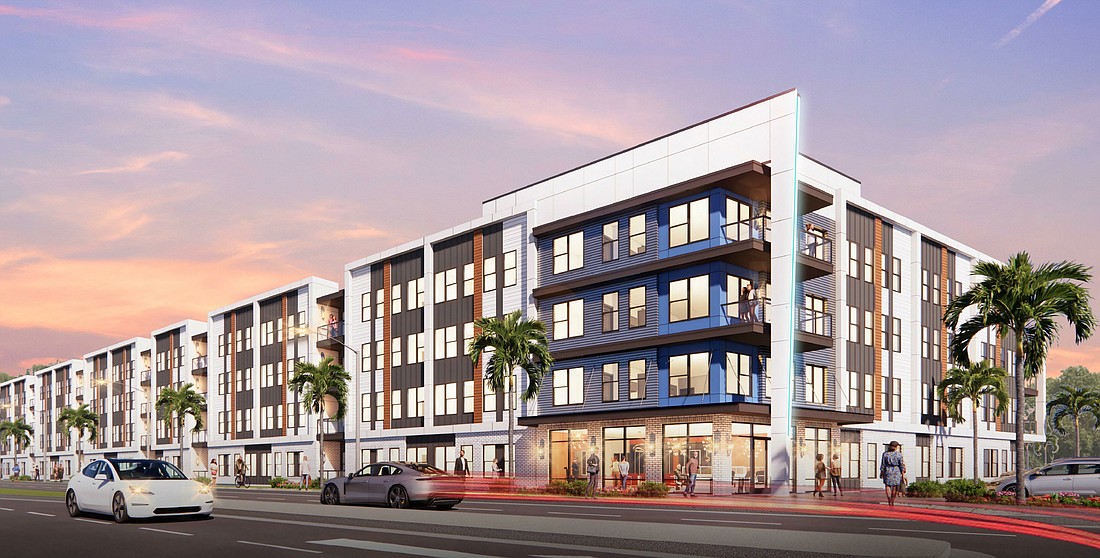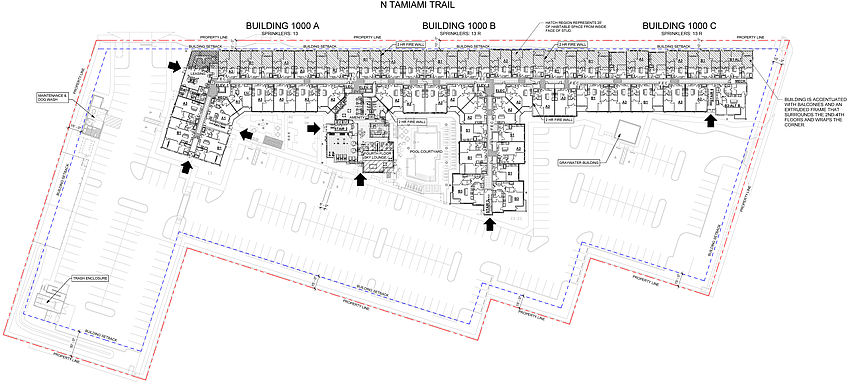- April 4, 2025
-
-
Loading

In January, the Sarasota Planning Board will wrestle with the issue of a downtown condominium tower, Obsidian, for which the primary opposition is over height. During its Dec. 13 meeting, a different project, Calypso Sarasota, had to overcome objections to its length — and lack of height — before winning approval by a 3-2 vote.
Totaling 224 rental apartments, Calypso will be a four-story building stretching more than two football fields along U.S. 41. Under the New Urbanism model of the North Trail Overlay District, it will stand about 13 feet from the edge of the roadway.
“I'm wondering if something can be done to kind of change the flow of the way this building looks on the outside,” said Chairman Dan Clermont, who joined Daniel Deleo in voting against site plan approval. “It has kind of a factory appeal to it, and if across the street somebody comes along and does the same thing, we’ve got quite a tunnel now, and I don't think that's terribly attractive. I don't think that that's really the nature of what we're looking for in North Trail Overlay District.”
Deleo wasn’t necessarily opposed to the site plan but rather to Vice Chairman Michael Halflants’ motion that included two conditions: to add two equally spaced pedestrian access doors into the building along U.S. 41 — the site plan showed entrances only at the lobby on the north end of the building and from the parking lot to the rear — and to raise the ground floor a minimum of 2 feet to add an element of privacy for the residents.

Throughout the board’s discussion, Halflants pressed developer Roers Companies to agree to raise the building for the benefit of first-floor residents facing North Tamiami Trail. Board member Terrell Salem suggested his experience as a firefighter responding to scenes where vehicles crashed into buildings near roadways necessitated either raising the building or adding a resilient knee wall to protect residents.
Halflants, an architect, suggested Roers could charge higher rents for ground-floor units with the enhancements, providing a return on whatever additional investment raising the foundation of the building would cost.
“I think that the point that Mr. Halflants made is a good point,” said Deleo to Halflants’ motion. “I think, however, that's not the development that was brought to us, and I think that the effect of that motion and those requirements probably are the same as a motion that turns the project down.”
Clermont clarified that if Halflants’ motion failed, another without the added conditions could be brought forth.
Whether Roers decides to build Calypso as approved remains to be seen. The “long run,” as Clermont described it, came about in part because the Florida Department of Transportation would not agree to two driveways of U.S. 41 to serve three separate buildings. Access points to the site are now shown at the north entrance to the development near the lobby area and off 42nd Street to the south.
Combined with North Trail District maximum setbacks, height restrictions, its 280 parking spaces and a state-permitted density bonus for utilizing graywater technology in the project — a system that recycles filtered sink and shower/tub water on-site for reuse as toilet water — the developer could only achieve its permitted 224 units as a single building.
In November 2022, the Planning Board approved what was then the twin developments of Sapphire North and Sapphire South, the two separated by a Super 8 motel. Combined, they would have brought 120 apartments to North Tamiami Trail.
Subsequently, Roers Companies of Plymouth, Minnesota, put the Super 8 property, owned by SAR Hospitality, under contract as well as the land for the twin Sapphires from Jarzi Realty Advisors of New York, then set about consolidating the entire 5.7-acre site into a single project.
When the expanded project first appeared before the Development Review Committee in January 2023, attorney Charlie Bailey presented a project of three buildings with two driveways off U.S. 41, a reduction of five curb cuts that previously existed serving several now-demolished buildings. Other than the Super 8 on 1.35 acres, which remains in operation, the remainder of the property had been cleared and is vacant.
Since then, FDOT declined to permit the two driveways along the state highway, and the single-building plan emerged as the requirements of the North Trail District, the city’s tree ordinance and setbacks from bordering single family residences compressed it “like a ballon,” Bailey said. “You squeeze it here and it bulges there.”
Some residents to the east of the project along Sarasota Avenue expressed concerns about on-street parking and cut-through traffic with the primary point of ingress and egress being off 42nd Street. A traffic study indicates a total of 79 net new trips may be anticipated during the afternoon peak hour when compared to the other vested land uses already built or approved for the site.
Those prior uses included a motel, a lingerie modeling boutique and an adult bookstore.
Still, Clermont was less than pleased with the potential pedestrian experience on a sidewalk between a 600-foot-plus long building up against U.S. 41.
Bailey said he doesn’t believe it will be a negative experience at all.
“I think from a traffic standpoint, the fewer driveway connections you have to interrupt the pedestrian flow kind of eliminates that pedestrian vehicle conflict,” Bailey said. “Anyone who happens to walking and is not a resident of this would just walk continuously along on U.S. 41 and have a better pedestrian experience than exists today.”